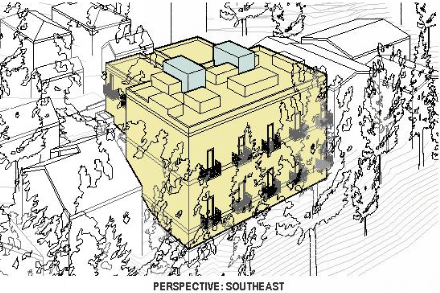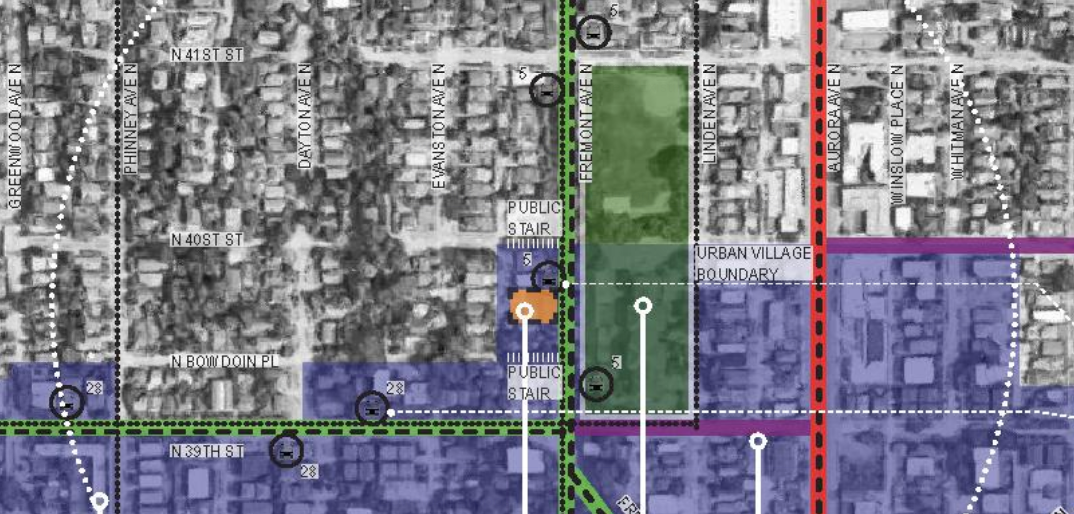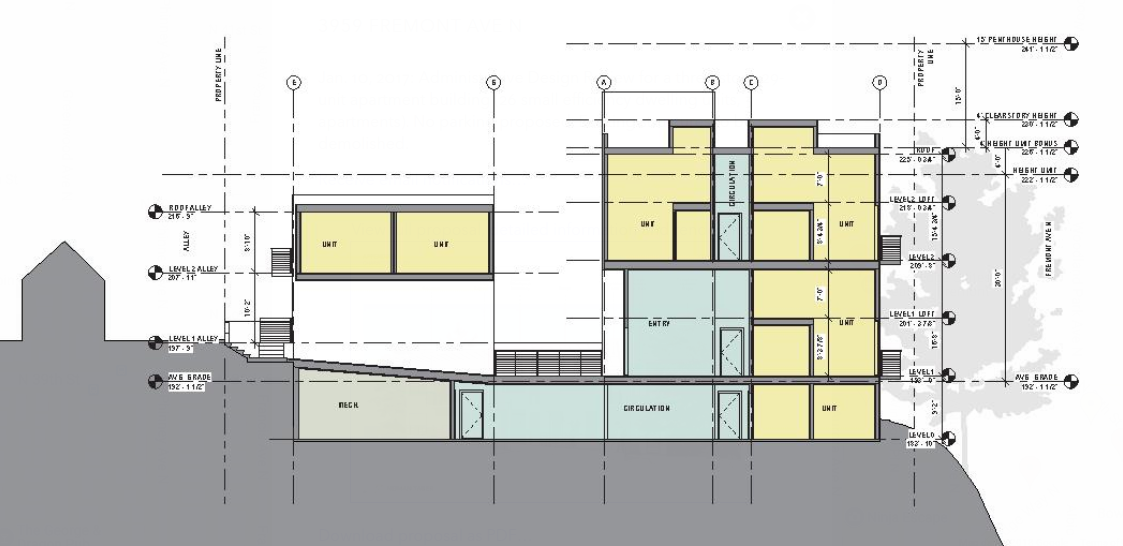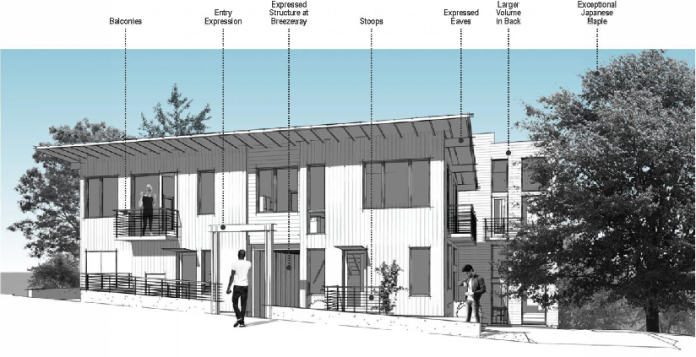The urbanist community spit-taked last week reading a glib op-ed in The Seattle Times that railed against a project planned for Fremont which includes small efficiency homes. The author (who lives in an ample Fremont townhome likely priced around $800,000) said living in a small efficiency is akin to “steerage” in a ship. Besides someone being wrong on the internet and the Seattle Times Opinion page, the “too small” argument–which is one plenty of housing opponents make–illuminates a contradiction in narratives.
One day earlier anti-housing ringleader John Fox had argued against tearing down Sheridan Apartments in his blog Outside City Hall because the studios within are relatively affordable at $1,170 per month. Fox failed to mentions the one-bedrooms seem to be renting for $1500 per month. Nevermind that the Sheridan has a very similar range of apartment sizes (at 340 to 525 square feet) as the project proposed for Fremont. But new housing opponents decry the Fremont project trying to replicate the Sheridan’s success at the same time as they rally to block the 440-apartment tower literally replacing the Sheridan (the exterior of the building will be retained). It seems like the common denominator here is opposing new projects–not preserving affordability.
Furthermore, we wrote about how John Fox’s infamous naturally occurring affordable housing (NOAH) surveys were heavy on apartments that A) weren’t actually that affordable and B) were relatively small studios. Ironically, many of these same folks oppose creating new small efficiency homes. By doing so, we’re creating a can’t-win situation. Mandating big home and lot sizes is a major reason why Seattle is on a Titanic-like course cleaving on an iceberg of massive inequality and displacement. We need the Housing Affordability and Livability Agenda (HALA) to keep this ship from going under. Yet apparently, some think we should try more of the same as we take in water. Seattle has led the nation in housing price increases two straight years.
Deconstructing Sheridan Concerns
It’s a similar story for the Sheridan. Fox says we’re losing 56 “affordable” homes. And we are, but since they were market-rate units only affordable by some combination of temporary landlord generosity or deferred maintenance, we couldn’t count on these NOAH units in red-hot Belltown to remain affordable for long without intervention. Fox estimates HALA’s Mandatory Housing Affordability (MHA) program will only replace 18 of these affordable units, but in actuality he’s comparing apples and oranges.
For one, the Seattle Office of Housing (OH) estimates that MHA funds leverage investments three or four times over since they are matched with other state, federal, and philanthropic funds. If OH leverages MHA funds 4:1 with other sources, then the 56 currently-affordable units would be replaced. Additionally, MHA units will be guaranteed affordable for 75 years at 60% to 80% of area median income. The Sheridan has no such guarantee. Nonetheless, folks who should know better, like two-time Seattle City Council candidate Jon Grant, amplifed Fox’s misleading claims. And they are misleading: Fox’s claim that 1:1 replacement of affordable units was previously mandated under incentive zoning is misleading since incentive zoning was previously optional.

We should seek to create more family-sized homes, and dedicate more housing levy and MHA funds to doing so. However, for plenty of Seattlites small efficiency homes work quite well and we shouldn’t belittle them by saying they live in steerage and insinuate there should be a law against living the way they do–which is one of the few ways they can afford to live in Seattle period. The other popular way to survive Seattle while of modest income is renting larger spaces and living with roommates, but classist concerns can be found for that arrangement too.
A Newbie Joins a Great Fremont Homeowner Tradition
Angela Elson, who penned the op-ed, made a show of checking her privilege. She acknowledged she’s wealthy, a “square,” and only moved to Fremont a year ago. She knows she’s not in the upper echelon of Fremont get-off-my-lawn homeowner cranks who’ve been agitating for decades against change in their neighborhood while their home values have doubled and tripled. But complaining about the new project down the block couldn’t be more conventional as far as Fremont and Wallingford homeowner activism goes. Couching those claims in concerns for the poor could not be more par for the course. Is she really concerned for people living in “steerage” or for herself having to live near said “steerage.” Street parking might even get a little tighter. Oh the horror!
She’s really a quick study, but the reality is these alligator tears are useless to Seattle’s rent-burdened masses. Give us more housing. Spare us the sob story about neighborhood character.
About 3959 Fremont Ave

A closer look at the Fremont small efficiency project hardly reveals the boogie man that Elson portrays. Will people have to take a slight detour or a steep scamble to reach Fremont Avenue? Yes, they will. Will people still happily choose to live there? Yes. Hills are kind of what people signed up when they moved to Seattle, yet Elson seems flabbergasted:
The kicker is that the hillside complex does not include access down to Fremont Avenue, which would force anyone differently abled to detour three or more blocks to access a main road. If you’ve ever walked up the steep slope of Fremont Avenue — or, God forbid, ridden a bike — I’m sure you can appreciate this undertaking.

Whether or not this site includes a private stairway to Fremont Avenue, people who can’t use the public stairs at N Bouduin St or N 40th St would conceivably still need to detour N 41st St to reach Fremont Avenue and a Route 5 bus stop–a three minute trip as a pedestrian. This holds true whether it’s built as townhomes or efficiencies. So is this a legitimate reason to block an efficiency project, or yet more concern trolling?

In contrast to Elson’s claims that the project is not well thought out, Neiman Taber Architecture has a reputation for designing livable small efficiencies. Microhousing is one of the firm’s specialities. The early design guidance proposal suggests a project well intergrated to the neighborhood and nestled between trees. Small balconies break up the facade and provide some outdoor space for tenants.
Architects will refine the early design ahead of the project’s Recommendation design review meeting. Even at this early stage, it’s clear that the 29 homes would make a positive impact on the Fremont neighborhood regardless of what you read a Seattle Times Opinion page.
Doug Trumm shared a tiny microhousing unit with a roommate while a college student like most other students, and he survived to tell the tale. In fact, he came away with almost exclusively fond memories. He shares a 500 square foot apartment with his spouse and his cat–less than 200 square feet for each of them–and by George they like it.
Microhousing Is Not A Prison Cell, Look To The Housing Crisis For A Villain
Doug Trumm is publisher of The Urbanist. An Urbanist writer since 2015, he dreams of pedestrian streets, bus lanes, and a mass-timber building spree to end our housing crisis. He graduated from the Evans School of Public Policy and Governance at the University of Washington in 2019. He lives in Seattle's Fremont neighborhood and loves to explore the city by foot and by bike.


